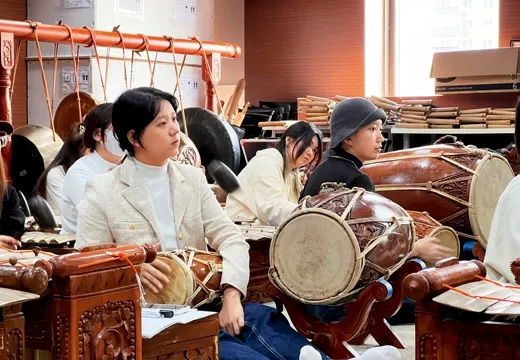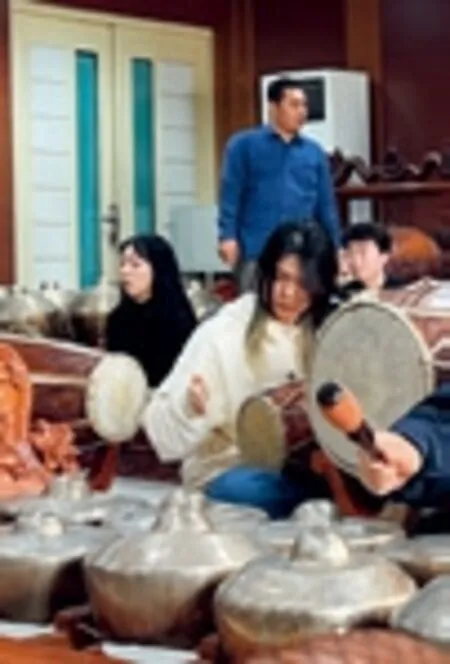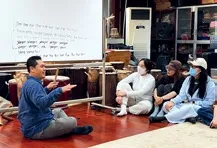Striking the Right Chords
By Gao Yuan

Students learn to play various gamelan musical instruments.
Cross-cultural communication through Indonesian gamelan education in China
In Classroom 711 of the main building at the Central Conservatory of Music (CCOM) in Beijing,more than a dozen students from different grades and majors sat on the floor,holding mallets for percussion instruments.With nervous anticipation,they stared at the musical notation on the whiteboard in front of them and prepared to play the instruments before them.Some occasionally hesitated to locate their next strike,but even a moment of distraction could cause them to lose rhythm completely,leaving them frantically scratching their heads to find their way back into the ensemble.One student confidently played the entire composition,only for the teacher to declare that not a single note had been played at the correct rhythm,leaving the student surprised and bewildered.
It was a normal day in a gamelan class at CCOM,the most prestigious music academy in China.Its students are among the most gifted musical talents in the country.Music tends to be their closest companion,and they have been learning it since childhood.It is rare for them to encounter situations in which they struggle to find the rhythm or fail to correct mistakes.However,learning gamelan,the traditional ensemble music from Indonesia,is an entirely new and unique experience.
Challenges for Teaching Gamelan in China
A gamelan ensemble is predominantly composed of percussive instruments such as the bonang,kendang,gong,rebab,and suling.It can be performed as pure instrumental music or as accompaniment to various artistic forms like dance,drama,and singing.With a rich history in Indonesia,gamelan has become a symbol of traditional Indonesian music.In the 19th Century,Western musicians encountered gamelan and were fascinated by its distinct tonal scales,musical structures,and compositional techniques,which greatly contrasted Western classical music.In the decades since,Western ethnomusicologists were greatly influenced by gamelan.Many basic theories of ethnomusicology were formed in the process of studying it.And today,many universities in Europe and the United States with ethnomusicology programs have dedicated gamelan music classrooms.
But in China,only a few universities such as the CCOM,Shanghai Conservatory of Music,and Ningbo University hold a complete set of gamelan instruments and offer permanent courses on the subject.Among gamelan teachers,Risnandar stands out as the only Indonesian in China,and he currently teaches at both ISI Surakart and CCOM.Born into a family of gamelan musicians in Central Java,Indonesia,Risnandar developed a passion for gamelan from an early age while playing and learning the instruments at home.He pursued studies in gamelan at ISI Surakarta and became a proficient performer and educator with a dual background in folk expertise and formal education.
Risnandar became connected to China in 2012 when the CCOM invited gamelan musicians from the ISI Surakarta to participate in the “World Music Week”event.Later,he was invited to conduct a short-term gamelan workshop at CCOM.Students’ enthusiasm for the art form was encouraging,so he started developing the workshop into regular courses,with a strong desire to promote gamelan culture in China.Since 2017,he has been offering an elective course in gamelan open to all students at the university.The course is divided into elementary and intermediate classes,each running for 16 weeks per semester,with two hours of classes per week.

Risnandar teaches a music class at the Central Conservatory of Music.
Zhang Kaifeng,a senior undergraduate majoring in vocal singing,called gamelan a very popular elective.He had been trying to enroll in the course since his sophomore year but could not get in until his senior year.“I major in Western classical vocal singing,and I find gamelan particularly refreshing and enjoyable,” he said.“At the same time,I find it quite challenging to understand gamelan within the framework of Western classical music theory.This is because gamelan is fundamentally different from Western classical music in terms of scales,modes,and theoretical concepts.Luckily,our teachers have provided localized gamelan teaching and encouraged us to form a gamelan orchestra,so that we can explore and appreciate this form of music in performance,which is a wonderful experience.”
Like Zhang Kaifeng,students at the CCOM all receive training in Western music theory as they progress.Even students in the Department of Chinese Folk Music learn Western music theory,practice with staff notation,and receive training in solfeggio and ear training.Each classroom is equipped with a piano.In contrast,Risnandar never learned to play the piano or violin at ISI Surakarta.He has exclusively studied within the realm of pure Indonesian traditional music.That brings considerable challenges to Risnandar’s teaching in China.
Conquering Challenges
Before the start of class,Risnandar wrote Javanese musical notation,similar to standard staff notation,using Arabic numerals on the whiteboard at the front of the classroom.He used this type of notation while teaching in Indonesia.In class,each student chose one gamelan instrument and sat beside it,ready to play in unison according to the numerical notation on the whiteboard.The students occasionally stood up and asked questions because they had difficulties in understanding the relations between the notation and the instruments as well as the patterns and variations in the music.Risnandar and his Chinese assistant,Zhan Bijin,paused frequently to provide explanations.
Boo Su Yong,a senior undergraduate majoring in Chinese folk percussion,served as the rhythm leader playing kendang.He expressed appreciation for the teacher’s trust but admitted,“The beat and rhythm of gamelan are quite different from the music I’ve been exposed to before,and I haven’t fully adapted to it yet(in the intermediate class).” He once mentioned to the teacher that the students were more accustomed to Western musical notation and suggested he alter the presentation.“If we have detailed notations written on the whiteboard,it would be much easier for us to catch up.”
Risnandar had made such attempts before.He and Zhan Bijin had previously used a Western symphonic music approach,composing separate staff notation for each instrument in the gamelan ensemble.However,the students became so engrossed in playing their own instruments that they disregarded the importance of coordination with other members of the ensemble.“This teaching approach proved unsatisfactory,” Risnandar said with a head shake.Gamelan is not about individual efforts but rather requires active listening,mutual attentiveness,and harmonious coordination among ensemble members.Through this foundation,improvisation can be incorporated.Essentially,it is a form of collective music creation.
Consequently,he switched back to providing only core melodic notations.He began constantly reminding students that playing gamelan requires listening and feeling rather than relying solely on reading the notation.
Cao Ran,a student majoring in musicology,commented that collaboration is both the greatest feature and the most challenging aspect of gamelan.“While playing my own part,it is crucial to know the rhythm and melody of the other parts,” she said.“This is something I rarely experienced in my previous musical endeavors.”
Risnandar has also made efforts to help students play with a more relaxed mindset.“Be happy,be joyful!” He always says these words in Chinese with enthusiasm and a smile during class.To establish a stronger connection with Chinese students,he started learning Chinese from Zhan Bijin and making an effort to speak Chinese in class.“Don’t be afraid of making mistakes” is what he says second most often.Risnandar demonstrates agreeableness in class because Chinese students highly value teachers’authority and tend to avoid making mistakes.He hopes everyone can relax and enjoy the music.In this regard,his assistant,Zhan Bijin,has a deep understanding.
Different Angles on Music
At the CCOM,courses taught by foreign teachers are always accompanied by Chinese teaching assistants.However,Zhan Bijin is not just an ordinary assistant who maintains classroom order and provides interpretation.She is one of the few young scholars in China to delve deep into the study of gamelan.From an early age,she has been receiving education in both Western and traditional Chinese music.In 2014,she started research on Indonesian gamelan.Now,she is a PhD candidate in world folk music at the Department of Music of the CCOM.
In 2014,Zhan accompanied her junior sister apprentice on a music field trip to Indonesia,where she developed a deep interest in gamelan.She then studied and played gamelan at ISI Surakarta for two years,an experience that brought about a significant cultural shock.In China,if someone starts dozing offwhile attending a concert,it likely indicates a lack of interest or even boredom with the music.However,Zhan reported that in Indonesia,“if the teacher dozed off while we were playing gamelan in class,it meant that we were performing exceptionally well.But if the teacher suddenly woke up,it was bad news—we must have made a mistake.” This state of ambiguity and relaxation starkly contrasts the boredom and drowsiness one might experience when unable to understand Western music.It is a state of relaxation.“That’s why gamelan is a form of music that aims to heal the soul rather than solely pursue artistic excellence,” she said.

Students sing the gamelan music according to the notation.

Risnandar (center) cooperates with teacher Zhan Bijin(second right) during class.

Students follow musical notation to play gamelan musical instruments.
“When we teach Chinese students about gamelan,our goal is to help them understand that,in addition to Chinese and Western classical music,every nation has its own unique music system.This includes scales,tuning systems,and different ways of interacting with music.Our students have been taught since childhood that learning music requires seriousness and discipline.How can they expect to step onto a formal stage without studying for ten or more years? Even after years of study and finally performing on stage,they still experience nerves,constantly striving to play each note and rhythm correctly.Most students at CCOM approach music with a serious and cautious attitude.However,gamelan offers a contrast to this mindset.” As Zhan Bijin put it,“Gamelan seeks relaxation,joy,and harmony.”

Risnandar and Zhan have been endeavoring to help students comprehend the unique aesthetics,values,and even worldview embedded in gamelan music.They consider this understanding to be more important than technical mastery.
“The students at our university possess exceptional musical talent and a strong ability to imitate,” remarked Zhan.“Even when confronted with an unfamiliar piece of music,they can proficiently perform it after studying for a while.However,they may not necessarily grasp the cultural connotations associated with that music.This is the aspect we aim to address in our class.Our hope is for students to transcend the inherent binary concepts of East and West and gradually cultivate a perspective encompassing diverse world music.We encourage them to explore the musical cultures of other nations and ethnic groups with curiosity,openness,and inclusivity.”
Collaborative Teaching
In class,Risnandar gathered the students together and demonstrated the scales on the Gender,one gamelan instrument.He then guided them in singing the melodies from musical notation.After several practice sessions,the students became proficient in singing the piece.Risnandar then asked Zhan Bijin to provide further elaboration to the students.
Zhan explained the unique flexibility of gamelan in terms of its tuning system,highlighting that no two sets of gamelan instruments have identical scales.What remains consistent are the interrelationships among the scales.Musicians can even customize their instruments according to their vocal range,and this is uncommon in the Western music system.“If you fail to grasp this,conducting fieldwork on gamelan can be quite overwhelming,” Zhan said.“When examining the vibrational frequencies of different gamelan instrument sets,you will discover that they are completely distinct.” She continued to share her personal experiences studying in Indonesia,captivating the students’ attention and occasionally eliciting genuine laughter.
“This is our teaching approach,” said Risnandar.He provides the teaching content while Zhan Bijin adapts it to suit the Chinese classroom.In other words,they utilize Indonesian teaching materials but employ a culturally comparative teaching methodology.They have now summarized their six years of collaborative teaching and are set to publish a textbook on teaching gamelan to Chinese students by the end of this year.This textbook will be the first of its kind in China.

At the end of a gamelan class,Risnandar teaches students to sing the music of Kecak,a traditional Balinese dance.

Gamelan musical notation.
Zhan declared both of them are fully committed to cross-cultural communication.The only divergence between them is in perception of cultural differences.Risnandar tends to focus more on similarities,whereas Zhan encounters and reflects more upon differences.Risnandar frequently mentions that living in China reminds him of the warmth and hospitality he experienced in his hometown,where people often warmly greeted each other,displayed mutual concern and understanding,and readily extended assistance in times of difficulty.These experiences were not as prevalent during his time in the United States and Northern Europe.Conversely,Zhan offers an alternative perspective.Both Indonesia and China are developing countries with a shared history of colonization.Through her study and teaching of gamelan,Zhan often contemplates why Indonesia has successfully preserved its cultural traditions whereas China has witnessed significant transformations in its traditional music and its people’s relationship with music.She aims to contribute to the future development of Chinese music from a global perspective.

